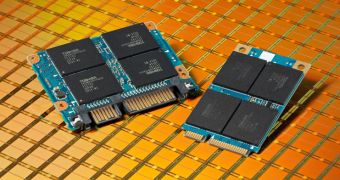Japanese electronics giant, computer company Toshiba is well known for its notebooks and electronics. It is also a small 2.5” HDD manufacturer and one of the biggest big NAND makers in the world, so it’s no wonder the company is planning on entering the SSD business.
Toshiba has been a 2.5” HDD manufacturer for some time now, and with some Western Digital technology, they’re now posing as a 3.5” HDD manufacturer, although they’re not making a single drive.
The only reason Toshiba has received any 3.5” HDD technology form WD is so that WD would be allowed by the authorities to buy Hitach, and thus form a global HDD duopoly with Seagate, after Seagate acquired Samsung last spring.
Toshiba’s next move was completely surprising and it only led us to believe that all their talk about seriously getting into HDD business with Hybrid HDDs and SSDs was only talk.
After acquiring the necessary 3.5” HDD patents and technology from Western Digital, Toshiba declared that they’d increase their HDD manufacturing by 30%, but they went on and sold a HDD factory to Western Digital.
That’s a strange way to increase production.
On the other hand, many hoped that Toshiba would get more serious about Hybrid HDDs or SSD and, while this seems to be the company’s next move, they’re not looking at SSDs as a commodity.
Currently, HDDs are a commodity and the price of the merchandise has been quite stable over time.
Developments in the field are quite slow and, unlike processors or RAM, the price of a HDD manufactured in January 2011 is likely to be the same one year later.
Because of the competition in the market, HDD prices have been very low in the past decade, and to ensure adequate profit margins, the HDD manufacturers have been ordering huge amounts of HDD parts from their suppliers.
Big orders meant big discounts and this was the only way HDD manufacturers were able to stay price competitive at $50 1TB HDDs.
The field was plagued with overproduction and has been this way for more than ten years. Practically, some HDD manufacturers had stocks of HDDs to last them a whole year.
When only Western Digital and Seagate were left to rule 90% of the global HDD market, the two companies used the Thai floods last year as a pretext to charge 300% more for their HDDs.
While the floods were real and production was even stopped for a few weeks, the huge stocks WD and Seagate had helped the companies supply even more HDDs than they had supplied the year before.
The increased prices also helped the companies increase their profits tenfold, like we reported here.
Many hoped SSDs would be able to take over and replace HDD, but despite the price reduction that we’ve experienced lately, the SSD technology will still cost considerably more than HDDs.
In an interview with XBitLabs, Joel Hagberg, vice president of marketing at Toshiba America reportedly said that:
“The NAND memory community is continuing to develop new technology which will improve capacity and lower cost per GB in each lithography change. As we move to SSDs based upon 1x nm NAND, we will enable higher capacity and lower cost SSDs. However, there are significant costs required to increase NAND Fab capacity and technical challenges must be overcome to make lithography changes. Because of this, there will continue to be a significant difference between the cost per GB of SSDs and HDDs.”
Practically, although making smaller NAND should reduce the manufacturing costs, SSDs will still remain quite a bit more expensive, as durability will become even a more serious issue than it currently is.
Smaller NAND is much less durable and the companies will have to seriously invest in technologies to improve the durability and reliability of their SSDs.

 14 DAY TRIAL //
14 DAY TRIAL //